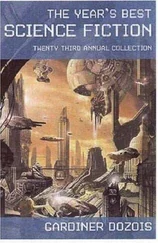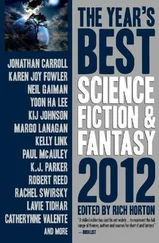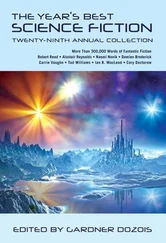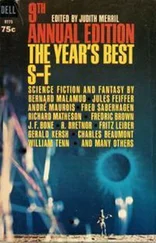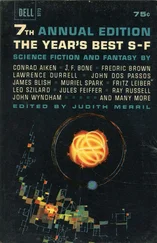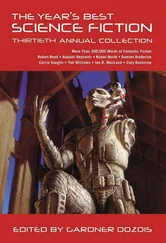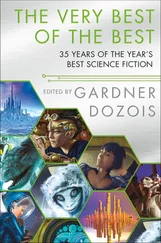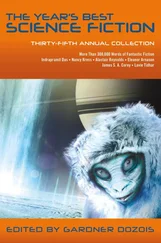Gardner Dozois - The Years Best Science Fiction, Vol. 20
Здесь есть возможность читать онлайн «Gardner Dozois - The Years Best Science Fiction, Vol. 20» весь текст электронной книги совершенно бесплатно (целиком полную версию без сокращений). В некоторых случаях можно слушать аудио, скачать через торрент в формате fb2 и присутствует краткое содержание. Жанр: Фантастика и фэнтези, на английском языке. Описание произведения, (предисловие) а так же отзывы посетителей доступны на портале библиотеки ЛибКат.
- Название:The Years Best Science Fiction, Vol. 20
- Автор:
- Жанр:
- Год:неизвестен
- ISBN:нет данных
- Рейтинг книги:5 / 5. Голосов: 1
-
Избранное:Добавить в избранное
- Отзывы:
-
Ваша оценка:
- 100
- 1
- 2
- 3
- 4
- 5
The Years Best Science Fiction, Vol. 20: краткое содержание, описание и аннотация
Предлагаем к чтению аннотацию, описание, краткое содержание или предисловие (зависит от того, что написал сам автор книги «The Years Best Science Fiction, Vol. 20»). Если вы не нашли необходимую информацию о книге — напишите в комментариях, мы постараемся отыскать её.
The Years Best Science Fiction, Vol. 20 — читать онлайн бесплатно полную книгу (весь текст) целиком
Ниже представлен текст книги, разбитый по страницам. Система сохранения места последней прочитанной страницы, позволяет с удобством читать онлайн бесплатно книгу «The Years Best Science Fiction, Vol. 20», без необходимости каждый раз заново искать на чём Вы остановились. Поставьте закладку, и сможете в любой момент перейти на страницу, на которой закончили чтение.
Интервал:
Закладка:
More generalized reference books this year included Supernatural Fiction Writers: Contemporary Fantasy and Horror, Volumes I amp; II (Scribner), edited by Richard Bleiler; The Battle of the Sexes in Science Fiction (Wesleyan), by Justine Larbalestier; Once There Was a Magazine (Beccon), by Fred Smith; John W. Campbell’s Golden Age of Science Fiction (DMZ), by Eric Solstein; Smokin’ Rockets (McFarland), by Patrick Lucanio and Gary Coville; and, probably the most accessible of these for the average reader, a collection of essays by horror writer Ramsey Campbell, Ramsey Campbell, Probably: On Horror and Sundry Fantasies (PS Publishing), by Ramsey Campbell.
The most generally enjoyable books in this category this year (or at least they sort of fit into this category; although they’re not a perfect fit anywhere) are two “travel guide” books, Roswell, Vegas, and Area 51: Travels with Courtney (Wormhole Books, 413 High St., Fort Wayne, IN 46808, $15.00), by Connie Willis, and A Walking Tour of the Shambles (American Fantasy Press, P.O. Box 1059, Woodstock, IL 60098, $15.00), by Gene Wolfe and Neil Gaiman. A Walking Tour of the Shambles is a whimsical and good-naturedly grotesque “travel guide” to an imaginary Chicago neighborhood filled with enchanted places and magical people, and Roswell, Vegas, and Area 51: Travels with Courtney is a caustic, sharp-eyed, and very funny tour through real places so bizarre and unlikely that they might just as well be the products of a fantasy writer’s fevered imagination (and it makes it even funnier that they are not).
As has been true for the last few years, the art book field was very strong this year. Among the best of the art books were Fantasy Art Masters: The Best in Fantasy and SF Art Worldwide (Collins), by Dick Jude; Paper Tiger Fantasy Art Gallery (Paper Tiger), edited by Paul Barnett; The Art of Jeffrey Jones (Underwood Books), edited by Cathy and Arnie Fenner; The Science Fiction Art of Vincent Di Fate (Paper Tiger), by Vincent Di Fate; Perceptualistics: Art by Jael (Paper Tiger), by Jael and John Grant; Manchu: Science (Fiction) (Guy Delcourt), by Manchu; Dragonhenge (Paper Tiger), by Bob Eggleton and John Grant; GOAD: The Many Moods of Phil Hale (Donald M. Grant), by Phil Hale, and the latest edition in a Best-of-the-Year-like retrospective of the year in fantastic art, Spectrum 9: The Best in Contemporary Fantastic Art (Underwood), by Kathy Fenner and Arnie Fenner.
There were only a few general genre-related nonfiction books of interest this year. The Extravagant Universe: Exploding Stars, Dark Energy, and the Accelerating Cosmos (Princeton University Press), by Robert P. Kirshner, may help you make sense of recent cosmological discoveries (primarily, that the universe is not only expanding, but accelerating as it expands) that have turned our entire picture of the nature of the universe upside-down. You may be prepared for some possibly even weirder future revelations if you check out one of the most fiercely controversial books in years, A New Kind of Science (Wolfram Media), by Stephen Wolfram, which puts forth the radical idea that the entire universe is controlled by the same basic set of rules that control cellular animations. To bring things back to Earth, there’s the late Stephen Jay Gould’s last book, The Structure of Evolutionary Theory (Harvard University Press), but although Gould’s lucid prose and experience at explaining scientific theory in comprehensible terms help, this is primarily aimed at specialists, and there are probably few laymen who are going to be willing to devote the time and brainwork necessary to absorb and comprehend its thousand-plus pages of text. For a less demanding and more easily graspable and enjoyable book that covers at least some of the same ground, take a look at The Life of Mammals (BBC Books), by David Attenborough, which examines in fascinating detail (complete with gorgeous color photographs) the strange and wonderful lifeways of some of the creatures we share our planet with, lifeways that are often far more astonishing and strange than those of most SF writers’s aliens. It’s hard to come up with a really credible genie-related justification for listing the next book, except perhaps that many SF fans are also history buffs, but in spite of that I’m going to recommend that you go out and buy a copy of The Cartoon History of the Universe III: From the Rise of Arabia to the Renaissance (W.W. Norton amp; Company), by Larry Gonick, one of the most informative, sharp-witted, erudite, and flat-out funny books you’re likely to find on the shelves anywhere, and one that’s perhaps particularly germane and valuable this year, as another war in the Middle East looms on the horizon, dealing centrally as it does with the birth and spread of Islam, and some of the root causes of misunderstandings between it and the West. Perhaps a similar weak justification could be used to work-in a mention of Sahara (St. Martin’s), by Michael Palin, which documents a grueling trip around the war-torn Saharan Africa, and shows just how closed-off and inaccessible many of the areas of our planet have become, as war, feral nationalism, and religious intolerance close border after border to the ordinary traveler, leaving us living on a planet where it may be easier to go to the Moon than to go from one country to the country next door.
It was another fairly good year for fantasy movies, but an unimpressive one for science fiction movies, in spite of the release of new entries in the two most successful media SF series of all time.
The big story of the year, easily overshadowing the new Star Wars movie in terms of the buzz and excitement it generated (and it is itself an interesting sign of the times that that can be said), was the second Lord of the Rings movie, The Lord of the Rings: The Two Towers. Although there are considerably more changes made here from the storyline of Tolkien’s text than there had been in the first movie, and in some ways more substantive ones, the movie remained true to the spirit of Tolkien’s great work, and all but the most fanatically obsessed fans seemed to be willing to cut Director Peter Jackson some slack. At any rate, although there were quibbles in plenty, they lacked any real force, and the overwhelming majority of Tolkien fans seemed willing to embrace the movie in spite of departures from the Sacred Cannon. There is a lot worth embracing: even if some of Tolkien’s more subtle nuances are lost, the movie is fast-paced and tremendously exciting, shot through with moments of both terror and wonder (although not as quite as many of the later as I’d have liked; the scene of Gandalf and Bilbo relaxing and blowing magical smoke-rings in Fellowship of the Rings was one of the most effective of the whole movie for me, and I’d liked to have seen a few more moments of quiet wonder here as well) and not only features good performances on every level from the live actors, but what is surely by far the best “performance” ever from a CGI-created or animated creature, as Gollum comes close to stealing the movies even from gifted professionals such as Ian McKellan and Christopher Lee. The Two Towers is certainly one of your very best bets this year for good value in return for your money, and if for some odd reason (a supernaturally enforced quota? An aesthetic diet?) you can only see one of 2002’s genre movies, this is undoubtedly the one to see.
The new Harry Potter movie, Harry Potter and the Chamber of Secrets, also seems to have satisfied its picky and fanatically loyal fan base, making few (if any) changes from the text of J. K. Rowling’s novel, and also did well at the box-office, although not quite as well as the first one had. It’s a darker movie, a lot more scary, more suspenseful and faster-paced than last year’s Harry Potter and the Sorcerer’s Stone, but with even less of the feeling of enchantment and wonder than the previous movie had managed to generate. As I said last year for a film about a school for magicians, especially one loaded with CGI-effects, the film lacks magic somehow-that’s even more true of Chamber of Secrets than it was of Sorcerer’s Stone, perhaps because the movie hurtles along at a headlong-enough pace not to have room for even the few evocative magical set-pieces the first film managed to work in. None of these quibbles matter anyway, though, because the movie’s main audience is kids, and the kids seemed perfectly happy with it, and, even more important, no doubt will be perfectly willing to drag their parents (willingly or unwillingly) to the next film in the series.
Читать дальшеИнтервал:
Закладка:
Похожие книги на «The Years Best Science Fiction, Vol. 20»
Представляем Вашему вниманию похожие книги на «The Years Best Science Fiction, Vol. 20» списком для выбора. Мы отобрали схожую по названию и смыслу литературу в надежде предоставить читателям больше вариантов отыскать новые, интересные, ещё непрочитанные произведения.
Обсуждение, отзывы о книге «The Years Best Science Fiction, Vol. 20» и просто собственные мнения читателей. Оставьте ваши комментарии, напишите, что Вы думаете о произведении, его смысле или главных героях. Укажите что конкретно понравилось, а что нет, и почему Вы так считаете.

